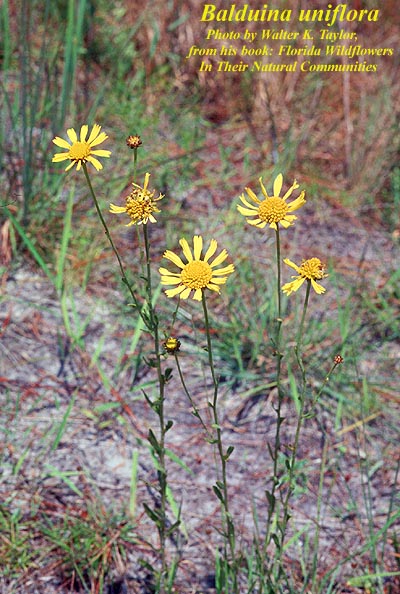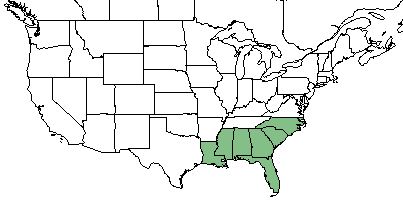Difference between revisions of "Balduina uniflora"
(→Taxonomic Notes) |
|||
| Line 20: | Line 20: | ||
==Taxonomic Notes== | ==Taxonomic Notes== | ||
| − | Synonym: ''Endorima uniflora''<ref name="USDA"/> | + | Synonym: ''Endorima uniflora''<ref name="Weakley 2015"/><ref name="USDA"/> |
==Description== <!-- Basic life history facts such as annual/perrenial, monoecious/dioecious, root morphology, seed type, etc. --> | ==Description== <!-- Basic life history facts such as annual/perrenial, monoecious/dioecious, root morphology, seed type, etc. --> | ||
Revision as of 13:26, 29 January 2018
| Balduina uniflora | |
|---|---|

| |
| Photo by Altas of Florida Plants Database | |
| Scientific classification | |
| Kingdom: | Plantae |
| Division: | Magnoliophyta - Flowering plants |
| Class: | Magnoliopsida - Dicots |
| Order: | Asterales |
| Family: | Asteraceae |
| Genus: | Balduina |
| Species: | B. uniflora |
| Binomial name | |
| Balduina uniflora Nutt. | |

| |
| Natural range of Balduina uniflora from USDA NRCS Plants Database. | |
Common Names: savanna honeycomb-head;[1] oneflower honeycombhead[2]
Contents
Taxonomic Notes
Synonym: Endorima uniflora[1][2]
Description
Balduina uniflora is a dioecious perennial that grows as a forb/herb.[2]
Distribution
It is found from eastern Louisiana, eastward throughout the panhandle of Florida and southeastern Georgia, and northward to southeastern North Carolina.[2]
Ecology
Habitat
This species is found in wet pine savannas and pine flatwoods.[1]
Phenology
In the southeastern and mid-Atlantic United States, flowering occurs from late July through September.[1]